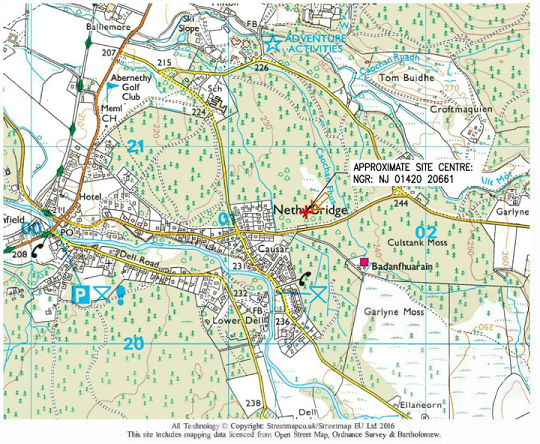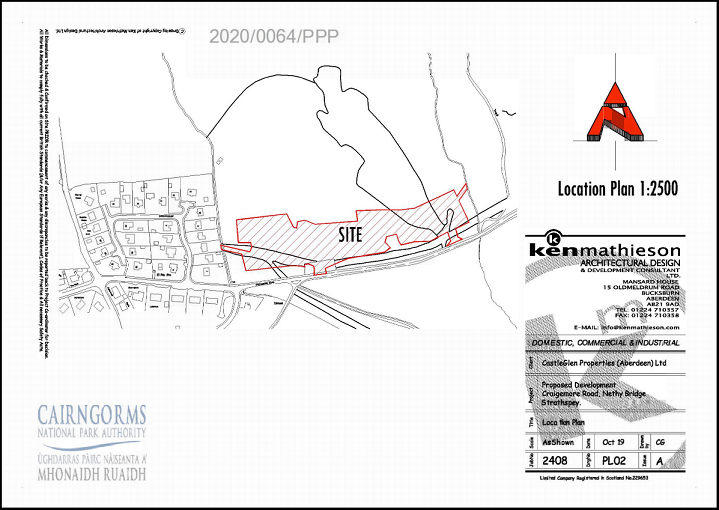The village of Nethy Bridge prides itself as being the Forest Village, being almost fully surrounded by woodland and forest, much of which is classified as ancient woodland. Yet tomorrow (see here for papers) Cairngorms National Park Authority planners are recommending approval of a planning application submitted by developer Castle Glen Properties of Aberdeen for the construction of 20 houses which would destroy a significant chunk of this. This post takes a critical look at the planners’ report following Roy Turnbull’s post earlier this week (see here) and my post back in April (see here).


This is a highly controversial planning application which has engendered considerable concerns amongst local residents.There are numerous major problems with this proposed development, all glossed over in the report or frankly just ignored or discounted. The key issue, however, is whether a Naional Park Planning Authority should recommend development within the remnants of ancient woodland or ancient woodland of semi-natural origin as is being proposed here?
What’s at stake for the Cairngorms National Park
The application provides a critical test for the CNPA, it is a test of whether it will defend the aims of this National Park, or whether development at the cost of our irreplaceable natural heritage is permitted to supersede all other considerations within the Cairngorms. As set up in law, the Cairngorms National Park has four main aims:
- To conserve and enhance the natural and cultural heritage of the area;
- To promote sustainable use of the natural resources of the area;
- To promote understanding and enjoyment (including enjoyment in the form of recreation) of the special qualities of the area by the public;
- To promote sustainable economic and social development of the area’s communities.
Furthermore, Section 9(6) of the Act setting up the Cairngorms National Park provides that if, in relation to any matter, it appears to the CNPA that there is a conflict between the first and other National Park aims, the CNPA must give greater weight to the first aim, namely to conserve and enhance the natural and cultural heritage of the area.
What is interesting is that on recently searching the CNPA website, I cannot find anywhere on the CNPA website reference to this clause which requires the CNPA to give greater weight to the first aim of the National Park. Any reference to the 4 aims, simply quotes the four aims and not this very important caveat [Ed. known as the Sandford Principle]. Is this a deliberate change in CNPA policy, and if it is, is CNPA risking breaking the law which set up the National Park?
My comments in my earlier blog concerning this application breaching all four aims of the Cairngorms National Park still stand:
Aim 1: To conserve and enhance the natural and cultural heritage of the area. Clearly a new development in an area listed in the Ancient Woodland Inventory as “Ancient of Semi-Natural Origin” will not conserve or enhance this woodland or the woodland that surrounds it.
Aim 2: To promote sustainable use of the natural resources of the area. Clearly building houses in an ancient woodland of semi-natural origin is not a sustainable use of this precious natural resource.
Aim 3: To promote understanding and enjoyment (including enjoyment in the form of recreation) of the special qualities of the area by the public. Building houses in this woodland will diminish public understanding and enjoyment of this special area of woodland. An example of supporting this aim was the recent BBC Springwatch series. Our National Park needs to build on this opportunity and reputation and not destroy it by approving developments within our natural woodland.
Aim 4: To promote the sustainable economic and social development of the area’s communities. Too often our CNPA Planning Authority interprets building new housing (especially with an affordable element) as being economically sustainable. Given the declared Climate Emergency, loss of ancient woodland is no longer sustainable development.
The CNPA’s own Ecology Officers, when consulted on this development by the planners, confirmed this and expressed major concerns, for example:
“We can advise that the site comprises of ancient semi-natural woodland habitat of high ecological value and the features present within the site indicate that the woodland is a rich and complex resource. The indicative plan seeks to mitigate the impact upon the site however even after this it will have a high significant and adverse ecological effect.”
And,
“It is widely accepted that the loss of ancient woodland is considered irreplaceable and therefore compensation for loss of this resource is not possible.”
It is worthwhile noting that, unlike other consultees, the CNPA’s own consultees are not permitted to formally object to planning applications, but can only express their concerns and recommend further actions.
So how does the CNPA planning officer justify recommending approval of this proposed development?
- The site was designated for housing in the 2015 Local Development Plan (LDP) for around 15 houses, not the 20 proposed here. However, the replacement 2020 LDP approved by the CNPA Board does not include it as a proposed development site, principally because of the impacts on ancient woodland habitat. The adopted 2015 LDP is now technically out of date but the examination of the new plan by the Government’s Reporter, which is required before the new can be finally adopted, was months overdue. Earlier this week the Reporter released their report on the draft plan (see here) and this accepts that this site should no longer be designated for housing. Why then the apparent rush to get this application to the Planning Committee before the report was received? Was the CNPA bowing to the developer or is it political pressure?
- 53 objections (see here) to this planning application were received by the cut-off date, with only one letter supporting the development. Out of line with the many local objectors, the Local Community Council gave it qualified support, but did not want to lose the grassland in the centre of the village for ‘compensatory woodland planting’. Instead the Community Council was pitching to be given woodland to manage on the community’s behalf. Despite all these valid objections, the report notes them, but then ignores them – so much for local democracy.
- The Report admits that, “The proposed development cannot fully comply with the Scottish Government’s Control of Woodland Removal Policy which has a presumption in favour of protecting Scotland’s woodland resource, and where woodland removal should only be allowed where it would have significant and clearly defined public benefits.” It then goes on to say, “In this application there is a conflict between delivery of the first aim of the National Park (to conserve and enhance the natural and cultural heritage of the National Park), and the fourth aim (to promote sustainable economic and social development of the area’s communities).”
- The Report is then very carefully worded: “However, in considering this planning application, members should be satisfied that they give greater weight to the first aim as required by Section 9(6) of the National Parks (Scotland) Act 2000, in reaching a decision.” Subsequently however, the argument shows bias towards the provision of 20 houses (half of which are likely to be holiday homes) thus putting greater weight on the 4th aim of the National Park (social and economic development) than on the primary aim (conserve and enhance the natural and cultural heritage).
This planning application is a key test of the performance of the Cairngorms National Park Board and its executive officers. Do they really believe in the first aim of the National Park having greater weight that the other three aims, or are they bowing to pressure from developers and certain elements of Scottish Government to make the fourth aim of the National Park carry the most weight? I have been convinced for some time that certain elements of the Scottish Government, including at Cabinet Secretary level, treat our National Parks like enterprise zones, using the beauty of the natural environment as a means of attracting development at the expense of our precious natural environment.
If the CNPA Planning Committee approves this application on Friday, then, like the already neutered SNH, which has been rebranded as NatureScot (be careful in the use of the capital S), CNPA will need to be rebranded as the Cairngorms Newtown Planning Authority.


What Needs to Happen
- To conserve the reputation of the Cairngorms National Park as a “National Park” and not an enterprise zone or development area, the Planning Committee needs to reject this planning application and put its statutory conservation aim first.
- If members feel bound by the out of date Local Development Plan, there are numerous reasons for deferring a decision to enable more information and clarification to be obtained until the 2020 LDP is approved by the Scottish Government. These, in themselves, provide further reasons for rejecting the development. There are:
- Questions over foul and surface water drainage and flood risk assessment, all contained in a 2014 report which is now well out of date and does not reflect the additional effects of climate change
- Questions over the adequacy of the developer’s ecological appraisal. The updated report is still based on two site walk over days in the middle of winter and is consequently totally inadequate for appraisal of such a sensitive ancient woodland site
- Questions on whether the so-called compensatory planting delivers any compensation, but ends up destroying a part of the village valued by its inhabitants
- Questions on the woodland management survey: the report refers to this survey and talks about a woodland management plan, but no plan has been presented or proposed, just a ’wish list’ of ideas. Remember, the profit from 20 houses will not create much money for a significant woodland management plan – it will end up being a token gesture at best, and nothing at worst. A much better solution would be for a professional body like The Woodland Trust to purchase woodland, including the woodland in the proposed development.
- Questions on the capercaillie impact assessment: the report maintains that most of the proposed development site already falls within a 150m disturbance zone, but it misses the obvious. This proposed development will extend the disturbance zone further into the woods, thereby limiting potential capercaillie movements.
- Questions on what form the access road improvements would take. How much more of the woodland and its sensitive ecosystems be taken away by road widening and other improvements?
- Further reasons for rejection or deferral can be found in some of the excellent objections submitted.
Let’s hope that the CNPA Board, who are all members of the Planning Committee, subject this planning report to detailed scrutiny and conduct their own critical appraisal before rejecting the application. Their deliberations can be viewed on-line (see here) from 10am tomorrow – its the first major item on the agenda -Friday 28th August.
A great blog setting out the basis for the consideration of the proposal tomorrow. Members of the CNPA Planning Committee can take a different view to the recommendations in the report. Planners tend to hold with the current, or latest allocation in a development plan. It’s the clearest and simplest option to take and is not often overturned at appeal. The general line is that applications are determined in line with the development plan unless ‘material considerations’ indicate otherwise. However, there are many significant ‘material considerations’ here that would indicate otherwise and Gordon refers to them above.
Material considerations that can justify a departure from the housing allocation in the development plan include:
1. The environmental impact of a proposal- the planners report accepts that the impacts are detrimental with loss of irreplaceable habitat but places technical and procedural weight upon an old allocation that has well evidenced detrimental environmental impacts on landscape and ecology.
2. The views of statutory and other consultees- consultees views are that the proposal is detrimental in terms of ecology and landscape.
3. Legitimate public concerns- these are clearly identified by the nature and number of objections from organisations and individuals and the fact that they relate to legitimate planning concerns such as environmental impact.
4. A proposed Local Development Plan- in this case there is not only a new proposed Cairngorms Local Development Plan that does not include the land for housing but also an endorsement from a Scottish Government Reporter that the land should not be developed.
The final consideration is the most significant, it provides an opportunity for officers to alter their recommendation tomorrow to refusal, or at least a deferral so that they can properly digest the reporters findings. Paragraph 19 of the planners report considers that only limited weight can be placed on the proposed development plan before 1. The Scottish Government Reporters findings are received and 2. The CNPA moves to adopt the new plan. The first part of this position is resolved by the recent receipt of the report and the move to adopt the plan (subject to Scottish Government approval) lies with the CNPA itself. Consequently, it now seems contradictory for the CNPA to recommend approval of the application when their position in their own new plan (endorsed by the reporter) is that they do not support the land being developed. A position as contradictory as this looks unreasonable and potentially open to challenge. Ultimately, if the recommendation remains approval there are more than adequate ‘material considerations’ for members of the Planning Committee to take a different view, reject the application and defend their position confidently
and robustly should the developer appeal.
Thanks for your well set out comments. Hopefully at least some of the Committee will read.
The planners report to committee seems to overlook the fact that the land is no longer zonned for housing, this is a very significant oversight. Disgraceful. I hope that the members of the planning committee are alive to this issue and remember the plan they have approved.
How many other sites have been left in the same state of limbo?
clearly, an unsustainable proposal.
consequently, contrary to all 4 aims of the Park.